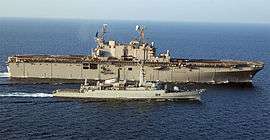PNS Badr (D-184)
PNS Badr (D-184) was the Tariq-class destroyer that served in the Surface Command of the Pakistan Navy from 1994 until being decommissioned from the service in 2014.[2]
 PNS Badr (D-184) in Northern Persian Gulf in 2005. | |
| History | |
|---|---|
| Name: | PNS Badr |
| Namesake: | Badr |
| Builder: |
|
| Laid down: | 28 September 1972 |
| Launched: | 18 September 1974 |
| Acquired: | 1 March 1994 |
| Recommissioned: | 26 June 1994 |
| In service: | 1994–2014 |
| Homeport: | Naval Base Karachi |
| Identification: | Pennant number: D-184 |
| Status: | Decommissioned.[1] |
| General characteristics | |
| Class and type: | Tariq-class destroyer |
| Displacement: | 3,700 long tons (3,759 t) full load |
| Length: | 384 ft (117 m) |
| Beam: | 41 ft 9 in (12.73 m) |
| Draught: | 19 ft 6 in (5.94 m) |
| Propulsion: |
|
| Speed: | 32 knots (59 km/h; 37 mph) |
| Range: | 4,000 nmi (7,400 km; 4,600 mi) at 17 knots (31 km/h; 20 mph) |
| Troops: | 2 × Btn, Pakistan Marines |
| Complement: | 192, 14 officers, 178 enlisted |
| Electronic warfare & decoys: |
|
| Armament: |
|
| Aircraft carried: |
|
| Aviation facilities: | Flight deck and hangar |
Before joining the Pakistan Navy, she was formerly designated as HMS Alacrity of the British Royal Navy as a general purpose frigate, and went through an extensive refit and midlife upgrade program by the KESW Ltd. at the Naval Base Karachi to have mission status to be properly qualified as the destroyer.[3]
Service history
Acquisition, construction, and modernization
She was designed and constructed by the Yarrow Shipbuilders, Ltd. at Glasgow in Scotland and was laid down on 5 March 1973; eventually, she was launched on 18 September 1974.[3] After a series of sea trials, she was commissioned on 2 July 1977 in the Surface Fleet of the Royal Navy as HMS Alacrity.[3] During her service with the Royal Navy, she was notable for her wartime operations during the Falklands War with Argentina.
On 1 March 1994, she was purchased by Pakistan after the successful negotiation with the United Kingdom and sailed off from Port of Plymouth to the Port of Karachi, arriving on 26 June 1994.[5]
Upon arriving in Karachi, she underwent an extensive modernization and mid-life upgrade program by the KESW Ltd. at the Naval Base Karachi in 1998–2002.[3]
In 2005, she was deployed to join the expeditionary strike group led by the U.S. Navy to engage in the relief efforts for the earthquake that struck the northern part of the Pakistan on 8 October 2005.
Her wartime performance included in deployments in patrolling off the Horn of Africa, Gulf of Oman, Persian Gulf, Arabian Sea, and Indian Ocean as part of the CTF-150.[7][8]
In 2014, it was reported that PNS Badr was decommissioned from service.[1]
Gallery
 PNS Badr steams alongside USS Tarawa, an amphibious assault ship, in the Northern Persian Gulf, participating in the relief operation for the earthquake that struck the northern part of the Pakistan on 8 October 2005.
PNS Badr steams alongside USS Tarawa, an amphibious assault ship, in the Northern Persian Gulf, participating in the relief operation for the earthquake that struck the northern part of the Pakistan on 8 October 2005.%2C_background%2C_joins_a_multinational_battle_group_formation.jpg) PNS Badr anchored with the Chinese Navy Guangzhou , the American USS Lake Champlain, and USS Theodore Roosevelt (the aircraft carrier in background) during the naval drill, Aman-09, hosted by Pakistan in the Indian Ocean in 2009.
PNS Badr anchored with the Chinese Navy Guangzhou , the American USS Lake Champlain, and USS Theodore Roosevelt (the aircraft carrier in background) during the naval drill, Aman-09, hosted by Pakistan in the Indian Ocean in 2009. PNS Badr steams alongside USS Tarawa in Northern Persian Gulf to participate in the relief operations in Northern Pakistan in 2005.
PNS Badr steams alongside USS Tarawa in Northern Persian Gulf to participate in the relief operations in Northern Pakistan in 2005.
References
- "Ex-Royal Navy vessels serving with other navies • The Military Times". The Military Times. The Military Times. 2 May 2018. Retrieved 20 November 2018.
- "PNS Tariq (F181) Guided-Missile Destroyer Warship - Pakistan". www.militaryfactory.com. military factory. Retrieved 20 November 2018.
- Shabbir, Usman (1 June 2003). "Tariq (Amazon) Class (TYPE 21) (DD/FF) « PakDef Military Consortium". pakdef.org. Karachi, Sindh Pak.: Pakistan Military Consortium. Retrieved 17 September 2018.
- Summary of World Broadcasts: SWB.. Asia-Pacific. Weekly economic report. BBC Monitoring. 1994. Retrieved 20 November 2018.
- "Frigate leaves for anti-piracy mission". DAWN.COM. 31 August 2009.
- "Defense.gov News Article: U.S., Pakistani Forces Complete 'Inspired Union 2008'". archive.defense.gov. Retrieved 20 November 2018.
External links
- "PNS Tariq". www.paknavy.gov.pk. ISPR Navy. Retrieved 19 November 2018.
- "Tariq (Amazon) Class (TYPE 21) (DD/FF) « PakDef Military Consortium". pakdef.org.